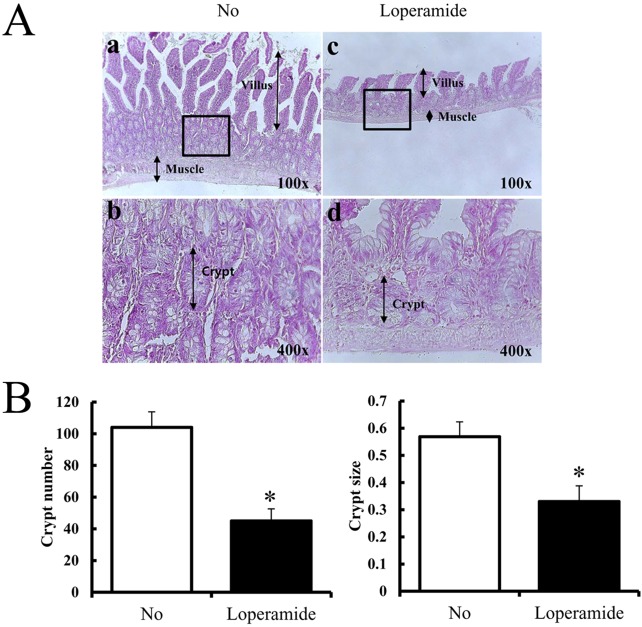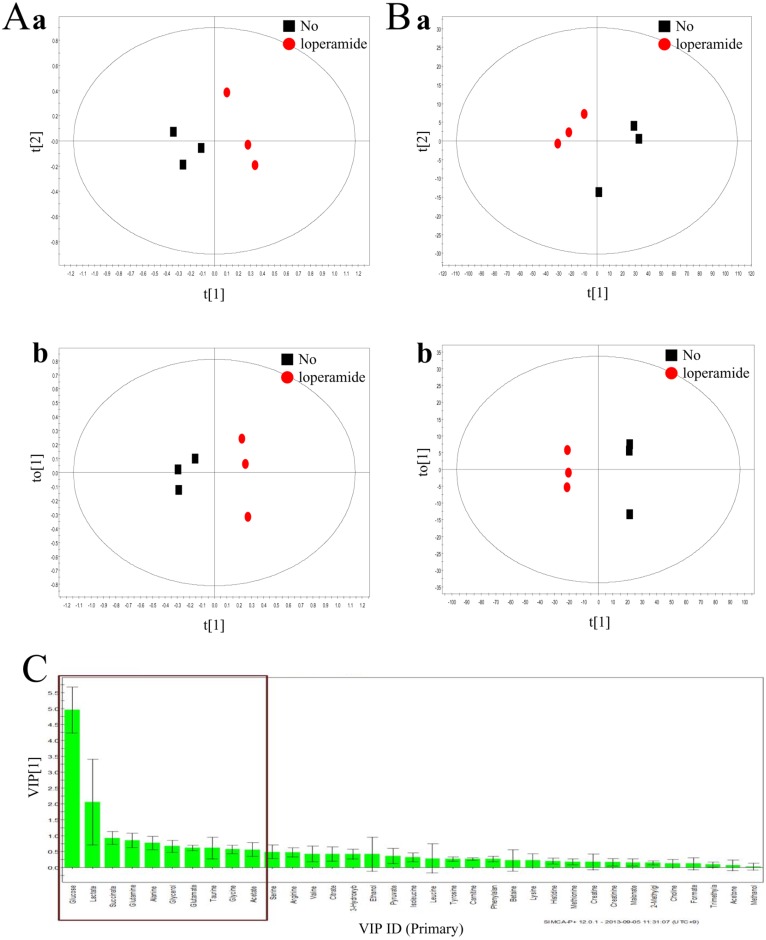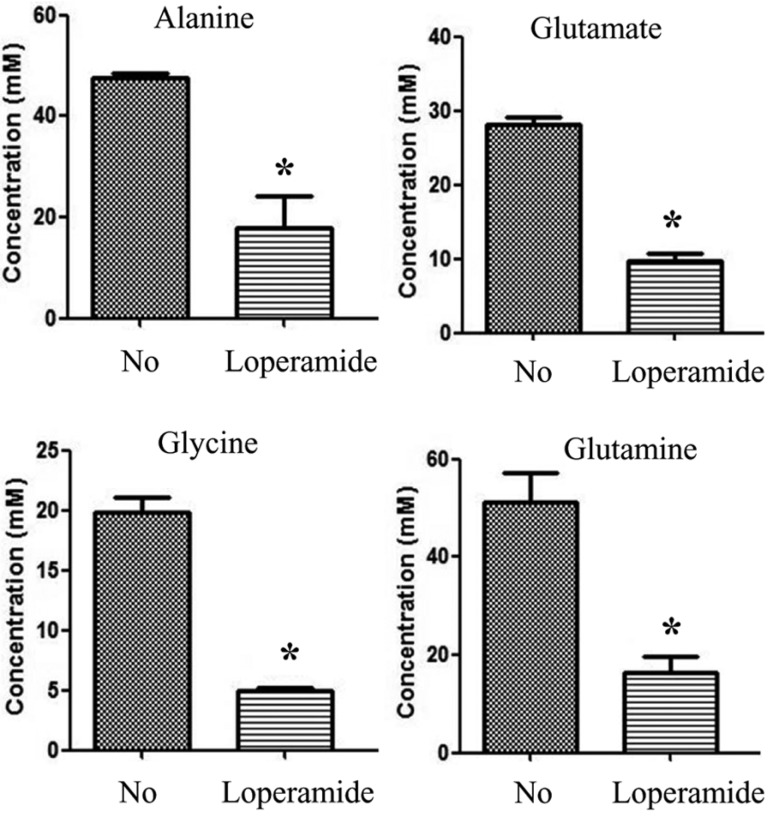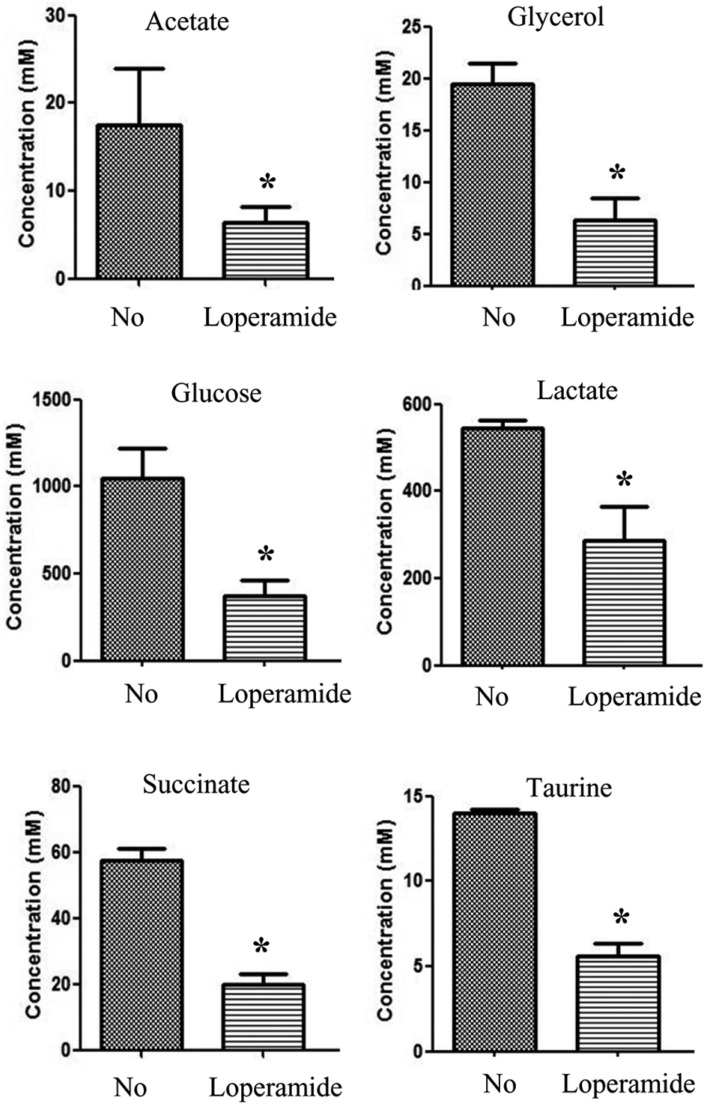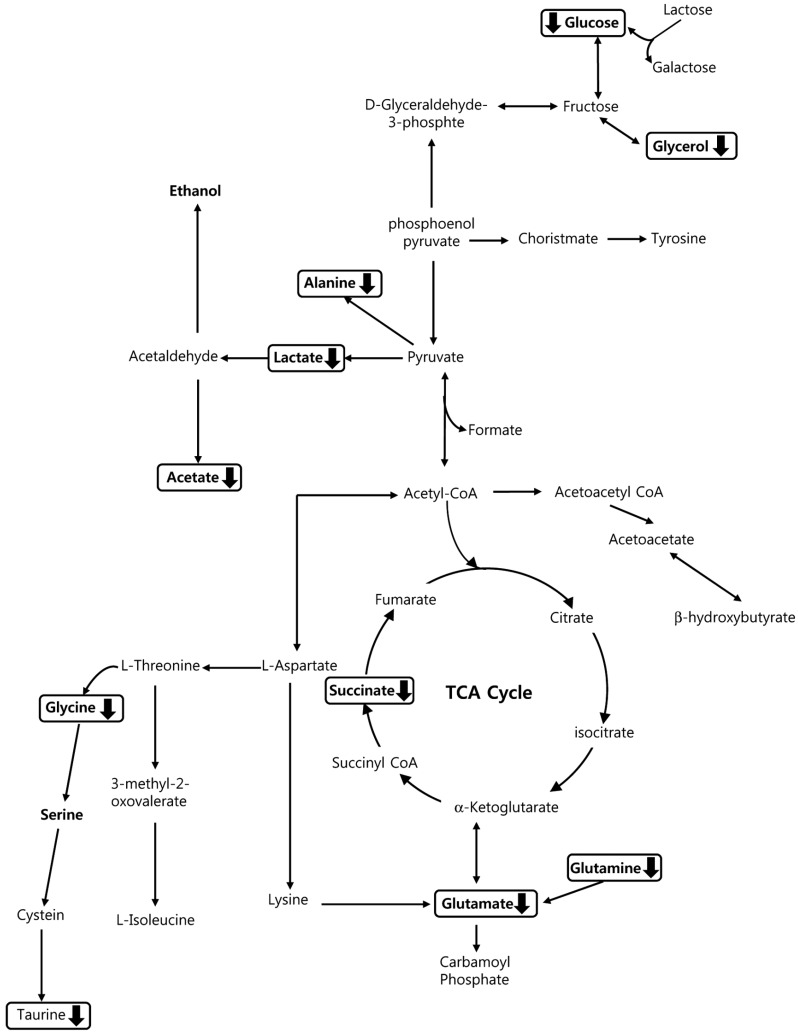Lab Anim Res.
2014 Mar;30(1):35-43.
Metabolomics approach to serum biomarker for loperamide-induced constipation in SD rats
- Affiliations
-
- 1Department of Biomaterials Science, College of Natural Resources & Life Science, Pusan National University, Miryang, Korea. dyhwang@pusan.ac.kr
- 2College of Pharmacy, Dankook University, Cheonan, Korea.
- 3Department of Medical Laser, Graduate School, Dankook University, Cheonan, Korea.
- 4Department of Chemistry and Chemistry Institute for Functional Materials, Pusan National University, Busan, Korea.
Abstract
- Loperamide has long been known as an opioid-receptor agonist useful as a drug for treatment of diarrhea resulting from gastroenteritis or inflammatory bowel disease as well as to induce constipation. To determine and characterize putative biomarkers that can predict constipation induced by loperamide treatment, alteration of endogenous metabolites was measured in the serum of Sprague Dawley (SD) rats treated with loperamide for 3 days using 1H nuclear magnetic resonance (1H NMR) spectral data. The amounts and weights of stool and urine excretion were significantly lower in the loperamide-treated group than the No-treated group, while the thickness of the villus, crypt layer, and muscle layer was decreased in the transverse colon of the same group. The concentrations of aspartate aminotransferase (AST), lactate dehydrogenase (LDH) and creatinine (Cr) were also slightly changed in the loperamide-treated group, although most of the serum components were maintained at a constant level. Furthermore, pattern recognition of endogenous metabolites showed completely separate clustering of the serum analysis parameters between the No-treated group and loperamide-treated group. Among 35 endogenous metabolites, four amino acids (alanine, glutamate, glutamine and glycine) and six endogenous metabolites (acetate, glucose, glycerol, lactate, succinate and taurine) were dramatically decreased in loperamide-treated SD rats. These results provide the first data pertaining to metabolic changes in SD rats with loperamide-induced constipation. Additionally, these findings correlate the changes in 10 metabolites with constipation.
Keyword
MeSH Terms
-
Amino Acids
Animals
Aspartate Aminotransferases
Biomarkers
Colon, Transverse
Constipation*
Creatinine
Diarrhea
Gastroenteritis
Glucose
Glutamic Acid
Glutamine
Glycerol
Inflammatory Bowel Diseases
L-Lactate Dehydrogenase
Lactic Acid
Loperamide
Magnetic Resonance Spectroscopy
Metabolomics*
Rats*
Succinic Acid
Weights and Measures
Amino Acids
Aspartate Aminotransferases
Creatinine
Glucose
Glutamic Acid
Glutamine
Glycerol
L-Lactate Dehydrogenase
Lactic Acid
Loperamide
Succinic Acid
Figure
Reference
-
1. Stokbroekx RA, Vandenberk J, Van Heertum AH, Van Laar GM, Van der Aa MJ, Van Bever WF, Janssen PA. Synthetic antidiarrheal agents. 2,2-Diphenyl-4-(4'-aryl-4'-hydroxypiperidino) butyramides. J Med Chem. 1973; 16(7):782–786. PMID: 4725924.2. Hanauer SB. The role of loperamide in gastrointestinal disorders. Rev Gastroenterol Disord. 2008; 8(1):15–20.3. Vandenbossche J, Huisman M, Xu Y, Sanderson-Bongiovanni D, Soons P. Loperamide and P-glycoprotein inhibition: assessment of the clinical relevance. J Pharm Pharmacol. 2010; 62(4):401–412. PMID: 20604828.
Article4. Katzung BG. Basic and Clinical Pharmacology. 9th ed. New York: McGraw-Hill Companies Inc.;2004. p. 321–370.5. Wintola OA, Sunmonu TO, Afolayan AJ. The effect of Aloe ferox Mill. in the treatment of loperamide-induced constipation in Wistar rats. BMC Gastroenterol. 2010; 10:95. PMID: 20723249.
Article6. Lee HY, Kim JH, Jeung HW, Lee CU, Kim DS, Li B, Lee GH, Sung MS, Ha KC, Back HI, Kim SY, Park SH, Oh MR, Kim MG, Jeon JY, Im YJ, Hwang MH, So BO, Shin SJ, Yoo WH, Kim HR, Chae HJ, Chae SW. Effects of Ficus carica paste on loperamide-induced constipation in rats. Food Chem Toxicol. 2012; 50(3-4):895–902. PMID: 22178225.7. Méité S, Bahi C, Yéo D, Datté JY, Djaman JA, N'guessan DJ. Laxative activities of Mareya micrantha (Benth.) Müll. Arg. (Euphorbiaceae) leaf aqueous extract in rats. BMC Complement Altern Med. 2010; 10:7. PMID: 20158903.
Article8. Hughes S, Higgs NB, Turnberg LA. Loperamide has antisecretory activity in the human jejunum in vivo. Gut. 1984; 25(9):931–935. PMID: 6590431.9. Sohji Y, Kawashima K, Shimizu M. Pharmacological studies of loperamide, an anti-diarrheal agent. II. Effects on peristalsis of the small intestine and colon in guinea pigs (author's transl). Nihon Yakurigaku Zasshi. 1978; 74(1):155–163. PMID: 640534.10. Yamada K, Onoda Y. Comparison of the effects of T-1815, yohimbine and naloxone on mouse colonic propulsion. J Smooth Muscle Res. 1993; 29(2):47–53. PMID: 8318729.
Article11. Yang ZH, Yu HJ, Pan A, Du JY, Ruan YC, Ko WH, Chan HC, Zhou WL. Cellular mechanisms underlying the laxative effect of flavonol naringenin on rat constipation model. PLoS One. 2008; 3(10):e3348. PMID: 18833323.
Article12. Bustos D, Ogawa K, Pons S, Soriano E, Bandi JC, Bustos Fernández L. Effect of loperamide and bisacodyl on intestinal transit time, fecal weight and short chain fatty acid excretion in the rat. Acta Gastroenterol Latinoam. 1991; 21(1):3–9. PMID: 1811403.13. Robertson DG, Watkins PB, Reily MD. Metabolomics in toxicology: preclinical and clinical applications. Toxicol Sci. 2011; 120(Suppl 1):S146–S170. PMID: 21127352.
Article14. Kim KB, Chung MW, Um SY, Oh JS, Kim SH, Na MA, Oh HY, Cho WS, Choi KH. Metabolomics and biomarker discovery: NMR spectral data of urine and hepatotoxicity by carbon tetrachloride, acetaminophen, and d-galactosamine in rats. Metabolomics. 2008; 4:377–392.
Article15. Kim KB, Um SY, Chung MW, Jung SC, Oh JS, Kim SH, Na HS, Lee BM, Choi KH. Toxicometabolomics approach to urinary biomarkers for mercuric chloride (HgCl2)-induced nephrotoxicity using proton nuclear magnetic resonance (1H NMR) in rats. Toxicol Appl Pharmacol. 2010; 249(2):114–126. PMID: 20804780.16. Kim KB, Yang JY, Kwack SJ, Kim HS, Ryu DH, Kim YJ, Bae JY, Lim DS, Choi SM, Kwon MJ, Bang DY, Lim SK, Kim YW, Hwang GS, Lee BM. Potential metabolomic biomarkers for evaluation of adriamycin efficacy using a urinary (1) H-NMR spectroscopy. J Appl Toxicol. 2012; 33(11):1251–1259.17. Mendrick DL, Schnackenberg L. Genomic and metabolomic advances in the identification of disease and adverse event biomarkers. Biomark Med. 2009; 3(5):605–615. PMID: 20477528.
Article18. Higgins PD, Johanson JF. Epidemiology of constipation in North America: a systematic review. Am J Gastroenterol. 2004; 99(4):750–759. PMID: 15089911.
Article19. Walia R, Mahajan L, Steffen R. Recent advances in chronic constipation. Curr Opin Pediatr. 2009; 21(5):661–666. PMID: 19606041.
Article20. McCallum IJ, Ong S, Mercer-Jones M. Chronic constipation in adults. BMJ. 2009; 338:b831. PMID: 19304766.
Article21. Emmanuel AV, Tack J, Quigley EM, Talley NJ. Pharmacological management of constipation. Neurogastroenterol Motil. 2009; 21:41–54. PMID: 19824937.
Article22. Bharucha AE. Constipation. Best Pract Res Clin Gastroenterol. 2007; 21(4):709–731. PMID: 17643910.
Article23. Nyam DC, Pemberton JH, Ilstrup DM, Rath DM. Long-term results of surgery for chronic constipation. Dis Colon Rectum. 1997; 40(3):273–279. PMID: 9118740.
Article24. Leung FW. Etiologic factors of chronic constipation: review of the scientific evidence. Dig Dis Sci. 2007; 52(2):313–316. PMID: 17219073.25. Shimotoyodome A, Meguro S, Hase T, Tokimitsu I, Sakata T. Decreased colonic mucus in rats with loperamide-induced constipation. Comp Biochem Physiol A Mol Integr Physiol. 2000; 126(2):203–212. PMID: 10936760.
Article26. Hou XY, Wang WL, Yong LI. DNA fingerprinting of intestinal flora in rats with slow transit constipation. J China Med Univ. 2013; 42:348–354.27. Kakino M, Izuta H, Ito T, Tsuruma K, Araki Y, Shimazawa M, Oyama M, Iinuma M, Hara H. Agarwood induced laxative effects via acetylcholine receptors on loperamide-induced constipation in mice. Biosci Biotechnol Biochem. 2010; 74(8):1550–1555. PMID: 20699592.
- Full Text Links
- Actions
-
Cited
- CITED
-
- Close
- Share
- Similar articles
-
- The Effect of Probiotic on Constipation in Rats
- Metabolomics approach to serum biomarker for laxative effects of red Liriope platyphylla in loperamide-induced constipation of SD rats
- Correlation between laxative effects of uridine and suppression of ER stress in loperamide induced constipated SD rats
- Laxative effect of peanut sprout extract
- Laxative effects of Liriope platyphylla are tightly correlated with suppression of endoplasmic reticulum stress in loperamide-induced constipation of SD rats

